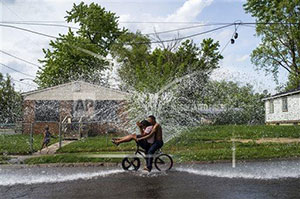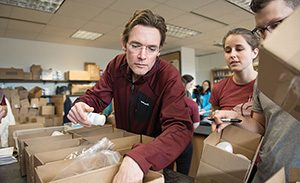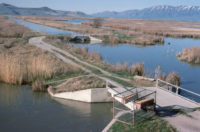In January, a year after Flint, Mich.’s corrosive, lead-tainted drinking water prompted President Obama to declare a state of emergency, Marc Edwards slept on a fold-out couch in a cold, empty home in the city to test its water at 3 a.m. That night, the testing showed the water was clear—a far cry from 2015, when the owner of the home, LeeAnne Walters, contacted the Virginia Tech civil and environmental engineering professor about the orange-and-yellow water that was giving her family rashes and poisoned one of her 5-year-old twin sons, Gavin.
Edwards’ first sample from Walters’ tap, in 2015, showed a lead level of 13,200 parts per billion. The U.S. Environmental Protection Agency (EPA) action level is 15 ppb, and water with lead above 5,000 ppb is considered hazardous waste. No level is considered safe.
Flint Mayor Karen Weaver (D) and many residents in this impoverished city of 100,000 say that, without Edwards’ help over the past two years, they still might be arguing with state officials about whether their water was safe to drink.

Five-year-old Gabriella Venegas screams out while a health official pricks her finger with a needle for a free lead test in 2016 in Flint Photo: Jake May/The Flint Journal-MLive.com via AP |
Edwards was shocked at the levels of lead, but he wasn’t surprised at the state’s reaction. The nationally known expert in water treatment and pipe corrosion had fought a decade-long battle with federal and local officials over lead in drinking water in Washington, D.C.
Learning from what didn’t go right in Washington, Edwards knew exactly what he had to do in Flint. Using his own money and his wife’s minivan, Edwards took his team to the city to conduct hundreds of water tests and publicly called out the government agencies that failed to implement corrosion control in 2014, when the city began using the Flint River as its source for drinking water.
The Virginia Tech team’s marathon efforts were a tipping point. Despite a year of outcry from residents and activists, Flint got no action until Edwards “proved something was indeed wrong with the water,” says Weaver.
Two years later, although the Flint crusade has taken its toll on Edwards, the engineer has helped to move the city’s water toward acceptable lead levels, inspired a rebuild of aging infrastructure and raised awareness of drinking-water problems throughout the U.S.
“In the big picture, there has been no doubt that this has made things better,” says George Hawkins, CEO and general manager of utility DC Water. “He has elevated the issue of lead in water to a national and international significance that it’s never been elevated to before.”
Edwards also has reminded the nation’s engineers of their key mission “to protect the public welfare above everything else,” he says. “The second you forget that, people pay a price.”
For using his expertise and passion to fight for safe drinking water and for demonstrating how professionals can and should sound alarms when necessary—even at the risk of their own careers—Marc A. Edwards is Engineering News-Record’s Award of Excellence Winner for 2017.
Related News and Opinion
After Flint, Michigan Pushes for Tougher Lead Rules
Lesson of Flint: Don't Be an Ethical Bystander
ENR's 2016 Newsmakers Went Above and Beyond
That it took an engineer based in southern Virginia, more than 500 miles away from Flint, to focus national attention on the city’s plight says as much about Marc Edwards, 52, as it does about those who dismissed the citizens’ complaints for so long.
“I don’t know if I’m principled or just a pain in the butt,” says the 20-year veteran of Virginia Tech. “I know other people aren’t wired quite the same way. It’s a curse in many ways.”
Amy Pruden, a Virginia Tech professor of civil and environmental engineering who works with Edwards advising graduate students, shares his outlook. “Marc is a different kind of person,” she says. “He really feels the pain and suffering of everyday people who experience the consequences of bad policy or poor science.”
His mother, Midge Edwards, says the traits her son showed in the Flint crisis—independence, determination, self-discipline, ingenuity and empathy—were apparent at an early age growing up in Ripley, N.Y. Marc, the third of four children, was always working toward some goal, whether winning a local pie baking contest at age 11 or getting the highest grades in the class, she recalls. “He’s got a tenacity there. He doesn’t give up, and he works the problem until he gets it done, no matter what gets in the way,” she says.
Edwards’ father, the former principal of Ripley’s one-building K-12 school, was an early role model. Carroll “Gene” Edwards suggested consolidating the school with a nearby rival as local demographics were changing. The blowback against the family from opponents in the community of 3,000 was fierce. Their home was repeatedly pummeled with tomatoes, some teachers made their displeasure clear to the Edwards kids, and Marc was beaten up more than once.
While the schools remained separate until 2013, Gene Edwards’ stand made a strong impact on his son years later, during the Washington, D.C., water-supply battle. “Through his experiences, he was able to help me,” Edwards says of his father, who died on his 85th birthday last October.
Marc Edwards Early Influences
Fascinated with science from an early age and encouraged by his high school science teacher, Edwards earned a B.S. in biophysics from the State University of New York at Buffalo. The work of local environmental activists inspired him to pursue engineering instead of medicine.
“Growing up on the shores of Lake Erie, I witnessed a dead lake brought back to life after implementing environmental controls and also the consequences of pollution on normal people living at [upstate New York toxic-waste site] Love Canal,” Edwards says. Earning M.S. and PhD degrees in environmental engineering from the University of Washington, Edwards was a standout student. “It was very obvious that he was quite a special talent from the moment he arrived,” says Mark Benjamin, a civil engineering professor emeritus who was Edwards’ adviser for his doctoral dissertation. At one point, Edwards’ master’s thesis was mistakenly entered into a competition for PhD candidates. His paper won.
Edwards’ first job taught him a hard lesson in engineering and set him on his lifelong path. He was employed by a consultant for the local water utility to mitigate “blue water” that was caused by too much copper in the San Francisco Bay Area water supply. Long-term exposure to excess copper can damage liver and kidneys. The firm’s engineers were told they should not help customers because the lawyers said the utility was not obligated to do so.
“Horrified” by the lawyers’ recommendation, Edwards was nonetheless fascinated by the scientific mystery of the blue-water problem itself, he says. His later postdoctoral engineering studies focused on drinking-water contamination in homes, and he helped to establish the field as a credible research area.
While teaching at the University of Colorado, Boulder, Edwards was selected as one of 20 young U.S. engineering faculty members to win a presidential fellowship for his work on water-system corrosion. He joined Virginia Tech’s faculty in 1997, attracted by its supportive faculty network, he says.
By 2003, Edwards had amassed millions of dollars in external research funding, authored 60 peer-reviewed publications and was elected president of the Association of Environmental Engineering and Science Professors. At the time, he and his wife, Jiu-Ling, had two small children, Ethan and Aileen, now 17 and 15.
But, looking back, Edwards terms himself a “suck-up” because he went along with institutional “group think,” did not question his own actions and was still naive about the world’s realities. That was about to change.
Pinhole Leaks
In 2003, EPA, through its subcontractor environmental consultant Cadmus Group, hired Edwards to investigate lead problems in Washington’s water system. Edwards field-tested the water from the pipes and found it had at least 80 times the amount of lead that the agency allowed. He later determined the lead was being leached out of the pipes because corrosive chloramine, rather than chlorine, was being used as a disinfectant. Lead poisoning is especially detrimental to young children, causing developmental delays and learning difficulties. In adults, it can lead to memory and concentration problems, joint pain and high blood pressure.
| “Bad decisions hurt people. That’s why the first canon of civil engineering is to protect the public welfare above everything else.” — Marc A. Edwards |
At the time, Edwards thought the problem would be quickly remedied after he notified officials of EPA and the Washington D.C. Water and Sewer Authority, which was rebranded DC Water in 2010. Instead, Edwards was told to stop working directly to resolve homeowners’ concerns or he would lose his contract work. He chose to work with the homeowners, and his $100,000 contract with EPA was history.
Months after Edwards raised the red flag, the agency notified residents about the problem. In June 2004, EPA cited the utility for withholding test results showing high levels of lead. The D.C. City Council, in turn, blamed the federal agency for lack of oversight of the city’s water system.
A Washington Post investigative series and congressional hearings shined a light on the city’s water problems. DC Water began using orthophosphate in the water to reduce corrosion, and EPA began closer oversight of the system. Today, lead levels range from 2 to 4 ppb, says CEO Hawkins. As a result of its lead crisis, the utility added new layers of lead monitoring, testing and communication with residents; it is still replacing lead pipes. Hawkins calls DC Water’s earlier lead problems “a hard learning experience” but says Marc Edwards is one of the reasons it is doing things differently now.
Benjamin, Edwards’ academic adviser who was regularly in touch, says his former student stepped into “a quagmire of both professional and ethical issues” as he encountered lead concentrations more typical of hazardous waste than drinking water; sampling techniques that systemically and grossly underestimated lead concentrations; and non-reporting or misreporting of critical data. Over the next several years, Edwards continued to battle for homeowners and fought misinformation from, among others, the federal Centers for Disease Control and Prevention, which falsely reported that increased lead in D.C.’s water did not boost lead levels in the blood. In 2010, the CDC admitted that its 2004 report did not include all the reported blood lead levels.
The Edwards family mortgaged their home to fund the D.C.-related research and pay for documents related to Freedom of Information Act requests to agencies. Edwards was hospitalized for stress and, at one point, thought he had poisoned his own family by forgetting to check the chemistry of well water at their rural Blacksburg, Va., home.
When Edwards “sees a corruption of the science that results or can result in harm, he expects that when the issues are pointed out to the utilities and regulators, the problems will be fixed,” says Miguel Del Toral, an EPA regulations manager who himself was a Flint whistle-blower. “When this does not happen, he understandably feels the need to conduct the scientific work to educate and inform the people who are being adversely affected.”
As Edwards fought the D.C. water battle, he became well known for helping water utilities solve plumbing mysteries. Dubbed by Time magazine in 2004 the “plumbing professor,” he published dozens of papers on water contaminants in peer journals and was recognized for his research, ethics and efforts to improve public health.
In 2007, Edwards received a $500,000 “genius grant” from the MacArthur Foundation for his advances in arsenic removal and the causes of copper and lead corrosion in new and aging water distribution systems. The funding allowed Edwards to set aside some of the money for the next water-related health crisis.
Then, in April 2015, LeeAnne Walters called.
All In for Flint
Flint residents had been dealing with the foul-smelling, rash-inducing tap water since 2014. At that time, to save $5 million over two years, the city switched to Flint River water from the Detroit system’s Lake Huron source. A state-appointed emergency manager was overseeing the financially strapped city, once a center of U.S. auto manufacturing.

Teens in Flint cycle through a fountain-like spray of water coming from a fire hydrant. Photo: Jake May/The Flint Journal-MLive.com via AP |
After much research on her own,Walters suspected—as did EPA water expert Del Toral—that the city was not using a chemical to control the corrosion from the river water that was leaching lead from miles of lead pipes. EPA superiors prevented Del Toral from finalizing a report on the issue. When one state official literally laughed in Walters’ face, she called Edwards. “People were holding up these bottles of water, bags of hair. They had rashes,” Walters says of one community meeting in January 2015. “We knew that no one was listening to us. There was all of this physical evidence, and no one cared.”
Walters and Edwards hatched a plan to scientifically prove the water’s toxicity. Edwards called together his students and asked if they wanted to go “all in for Flint.” They didn’t hesitate. “You want to know what’s going on and help them if you can—it’s an engineering instinct,” says Min Tang, a civil and environmental engineer working on postdoctoral studies under Edwards.
Edwards’ team, which started with 10 students and researchers and eventually grew to more than 40, assembled 300 tamper-proof water-sampling kits. Walters and a small army of volunteers distributed the kits. The first batch of tests showed that 17% of the homes had lead levels over 15 ppb and several exceeded 100 ppb. “It was a pretty intense time. You literally felt that a city was being poisoned,” Edwards says. “Everyone involved was just working crazy hours for free.” The Flint team “did the most thorough independent evaluation of a water system in U.S. history,” Edwards says. The team checked for disinfection by-products and contaminants, including lead, fecal contamination, opportunistic pathogens and corrosion-causing microbes. “We left no stone unturned,” he says.
One of the group’s first concerns was legionella. After the Flint water switch in 2014, Legionnaires’ disease killed 12 people and made 90 people sick. The Flint team suspected that the Flint River’s corrosive water leached iron from the system’s iron pipes. That iron, in turn, removes chlorine in the water system that normally would have killed the legionella bacteria. The bacteria also fed off the excess iron. Later testing in the Virginia Tech laboratory confirmed this hypothesis.
After the test results showed there were dangerous levels of lead in the water, Edwards asked doctoral student Anurag Mantha to call the Flint residents and notify them that they should stop drinking the water and buy bottled water or buy filters for their taps. When Mantha realized many residents couldn’t afford the $20 filter, he began buying them with his own money and sending them to Flint. Mantha’s effort eventually morphed into a multimillion-dollar United Way campaign to supply every Flint resident with a filter.
“We had a real and direct impact almost instantaneously in most cases,” Mantha says. “It made me realize what an impact scientists and engineers can have on the public.” Calling the water-switch decision “epically bad,” Edwards went public with test results in a press conference and on a webpage the team created, Flintwaterstudy.org.
Then, in September 2015, local pediatrician Mona Hanna-Attisha released a study that found twice as many children under 5 years of age had elevated blood levels than before the drinking-water source was switched, with some up to 100% higher. One week later, Michigan declared a public health emergency. One month later, the city was reconnected to Detroit water. Since then, Hanna-Attisha, Edwards and Walters have all testified to Congress about what happened in Flint.
While the physician credits Flint residents and others in the crusade, she says that, without Edwards, “we would be nowhere because everybody had been raising their voices and advocating and [they] were dismissed. He brought the critical voice of science.”
After the city and the state admitted the water supply was a problem, Edwards was appointed to oversee water testing, which he continues to do. Flint has replaced about 800 lead service lines. In March, a lawsuit brought by residents was settled, requiring the city and state to pay $97 million to replace 18,000 water pipes by 2020. The federal government has committed about half that money.
State Attorney General Bill Schuette (R) has brought criminal charges against 13 former state and local officials and filed a civil suit against engineering companies Veolia North America and Lockwood, Andrews & Newnam for professional negligence. Both city water-supply consultants have said in statements that they had no responsibility for the decisions that led to the lead problems.
Edwards notes that, unlike in Washington, D.C., everything went as well as it possibly could in Flint. He says the response from all agencies has been “unprecedented.” George Krisztian, who was appointed city action-plan coordinator for the Michigan Dept. of Environmental Quality, appreciates that Edwards can work with the agencies he once castigated. “Marc is very open-minded. He listens very intently to people with opposing viewpoints, and he gives due consideration to what others have to say,” Krisztian says.
Edwards serves on the state interagency committee that is assisting Flint. He expects to be involved in the city for perhaps another three years, helping with a wide range of problems. “All I can say about the Flint experience is that, at one level, I wouldn’t wish it on anyone. But I wouldn’t change it for anything in the world, either,” Edwards says. “At the end of the day, everyone who was involved in that battle had such a sense of purpose. We felt like we were doing the job we were born to do.”
Edwards says his life now is like a reality show, with dozens of media requests each month and daily inquiries from people whose water is blue or orange or smells bad. Talking to each, he sometimes deploys his team to investigate. He also helps engineering and science peers to research and publicize their own similar investigations. “His words gave me the strength to continue on, even through the darkest hours,” says Adrienne Katner, an assistant professor of environmental health sciences at Louisiana State University who, last year, exposed water problems in St. Joe, La., with Edwards’ support.
The American Society of Civil Engineering last year cited Edwards for his efforts, calling him “a tireless advocate for the protection of the nation’s drinking-water supply.” The advocate is now on sabbatical from teaching, but that hasn’t slowed down the lanky, 6-ft, 1-in., marathon runner, who says running at midnight helps him to sleep.
Controversies Over the Flint Crusade
Virginia Tech colleague Pruden, who is working with Edwards to direct studies of legionella and other opportunistic pathogens in water heaters and home plumbing, says the Flint crisis awakened the nation to “injustices” in drinking-water regulations that leave water systems in poor and small communities vulnerable. She and Edwards want loopholes tightened in federal regulation of legionella, and of lead and copper in drinking water (see After Flint, Michigan Pushes State Lead Rules Beyond Federal).
While water industry officials laud Edwards for spotlighting water-supply infrastructure and regulatory problems, some say his criticism is too pointed and does not reflect the shades of gray in the real world. “The other side has another story,” which Edwards sometimes does not want to hear, says John Sullivan, chief engineer of the Boston Water and Sewer Commission. “There just isn’t enough money to take out the lead pipes immediately. Being a good engineer doesn’t mean we have to stop the world today. We don’t have the resources.” Sullivan says the industry has alternatives to protect consumers, such as recommending flushing lines before use and installing lead filters.
Reaction to Edwards' Flint Crusade
Hawkins of DC Water says he understands where Edwards is coming from, but he also can relate to his water-sector peers who are offended at the Virginia Tech engineers’ methods. “Marc comes into things with guns blazing in every direction. … Sometimes it’s like friendly fire,” Hawkins says, adding that Edwards’ criticisms of his water-industry peers can sometimes hit those who are more on his side than against him.

Marc Edwards and students prepare water-testing kits to be distributed to Flint residents in Edwards’ lab at Virginia Tech in the spring of 2016 in preparation for a second round of testing of homes in Flint. Photo courtesy of Virginia Tech |
In an editorial last September in industry publication Environmental Science and Technology, Editor-in-Chief David Sedlak wrote that Edwards’ advocacy threatens the “social contract that underpins the tradition of financial support for basic research,” because government agencies and organizations that support such research want objective scientists.
In responding, Edwards emphasized that “staying silent is to be complicit in perpetrating injustice.” He added, “No matter what may come of the rest of our lives or careers, we are certain of one thing: Flint was a community worth going out on a limb for, and by upholding a just cause, we enhanced the social contract between academics and the public.”
Virginia Tech President Timothy D. Sands, a materials engineer, says Edwards’ actions have indeed improved the university’s connection to the public. The school created a new award—funded at $500,000 over five years—to support Edwards and Hanna-Attisha in their work for Flint.
Named after the university’s Latin motto “Ut Prosim,” which translates to “That we may serve,” the award will be available to other faculty for their public service efforts. “We are learning from him and trying to incorporate some of the things he values,” says Sands. “I think we’re starting to change the conversation.”
Edwards is starting to change the conversation for students, too. Louisiana State’s Katner calls him a “rock star” to young scientists and engineers. In class and through the Flint experience, Edwards’ students have learned firsthand the impact they can have.
“Engineers can be the change-makers of society,” says Joyce Xiu, a PhD candidate in environmental and civil engineering and a Flint team member.
While Edwards is passionate about continuing his research, he says, “I live to recast the engineer’s life journey as one of self-actualization.”
According to the academic, an engineer’s harm to the public often comes not from one monumental action but from small, unchecked decisions that are made by many people. “You can have these big evils [in which] everyone involved has a little tiny part, and each part on its own is defensible to the person involved, but you end up with giant lies that create tragedies that hurt people,” he says.
Edwards’ influence has reached beyond Flint and the Virginia Tech campus, with the crisis already a case study in engineering ethics classes around the nation. “My bottom line to students is, you can be like these people who were more concerned about protecting the agency, or you can have the courage to stand up when you see something that is being done incorrectly,” says former Edwards adviser Benjamin.
“I think his influence is much greater than he realizes,” says William Marcy, 75, director of the National Institute for Engineering Ethics at Texas Tech and its former provost. “We may not see the results in my lifetime, but we hopefully will in his.”














Post a comment to this article
Report Abusive Comment